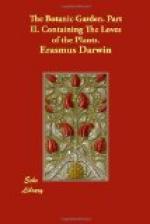For
him she breathes the silent sigh, forlorn,
Each
setting-day; for him each rising morn.—
“Bright
orbs, that light yon high etherial plain,
400 Or bathe your radiant tresses in the main;
Pale
moon, that silver’st o’er night’s
sable brow;—
For
ye were witness to his parting vow!—
Ye
shelving rocks, dark waves, and sounding shore,—
Ye
echoed sweet the tender words he swore!—
405 Can stars or seas the sails of love retain?
O
guide my wanderer to my arms again!”—
Her
buoyant skiff intrepid ULVA guides,
And
seeks her Lord amid the trackless tides;
[Ulva, l. 407. Clandestine marriage. This kind of sea-weed is buoyed up by bladders of air, which are formed in the duplicatures of its leaves; and forms immense floating fields of vegetation; the young ones, branching out from the larger ones, and borne on similar little air-vessels. It is also found in the warm baths of Patavia; where the leaves are formed into curious cells or labyrinths for the purpose of floating on the water. See ulva labyrinthi-formis Lin. Spec. Plant. The air contained in these cells was found by Dr. Priestley to be sometimes purer than common air, and sometimes less pure; the air-bladders of fish seem to be similar organs, and serve to render them buoyant in the water. In some of these, as in the Cod and Haddock, a red membrane, consisting of a great number of leaves or duplicatures, is found within the air-bag, which probably secretes this air from the blood of the animal. (Monro. Physiol. of Fish. p. 28.) To determine whether this air, when first separated from the blood of the animal or plant, be dephlogisticated air, is worthy inquiry. The bladder-sena (Colutea), and bladder-nut (Staphylaea), have their seed-vessels distended with air; the Ketmia has the upper joint of the stem immediately under the receptacle of the flower much distended with air; these seem to be analogous to the air-vessel at the broad end of the egg, and may probably become less pure as the seed ripens: some, which I tried, had the purity of the surrounding atmosphere. The air at the broad end of the egg is probably an organ serving the purpose of respiration to the young chick, some of whose vessels are spread upon it like a placenta, or permeate it. Many are of opinion that even the placenta of the human fetus, and cotyledons of quadrupeds, are respiratory organs rather than nutritious ones.
The air in the hollow stems of grasses, and of some umbelliferous plants, bears analogy to the air in the quills, and in some of the bones of birds; supplying the place of the pith, which shrivels up after it has performed its office of protruding the young stem or feather. Some of these cavities of the bones are said to communicate with the lungs in birds. Phil. Trans.




